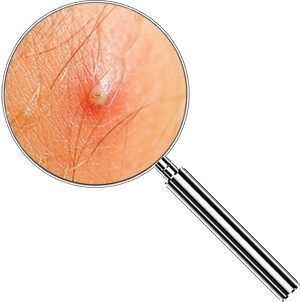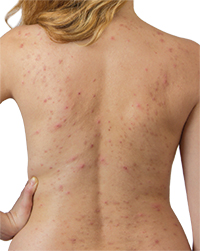While folliculitis is very common – in fact, most men and women will develop some form of it in their lifetime – some people with compromised immune systems may be more prone to it. For instance, a client undergoing chemotherapy or who has HIV or AIDS or is diabetic may be more prone to developing folliculitis.
Mild cases of folliculitis often clear up in a few days, however, more severe cases may need to be treated with an antibiotic from a physician. When folliculitis is in a more severe form, it can have a burning sensation and have a severe itch. More severe cases could cause scarring of the surface skin. There have also been documented cases in which there has been permanent hair loss from severe folliculitis.
When encountering suspicious looking skin conditions that could be folliculitis, keep in mind, clients may not always pay attention to their body, so they may not have noticed the abnormal condition. If they have, they may not think the condition is something of concern. Or, they may not want to think about the condition because they are in fear of it being something serious. Remember to be diplomatic and sensitive to the fact that the condition may be embarrassing for the client. When it comes to folliculitis, knowing key facts, like when to refer to a physician, common forms and causes, and waxing and shaving precautions, can aid in addressing such issues in an effective and sensitive manner.
WHEN TO SEEK MEDICAL TREATMENT
 It is important to know how long the condition has been present. When folliculitis has been present for more than a few days and has some of the more severe symptoms – such as a wide spread presence, a mixture of red bumps and white heads, or crusted sores with burning and itching sensations – recommend that the client seek medical treatment. In most cases, the physician will prescribe an antifungal or antibiotic medication to help treat the condition.
It is important to know how long the condition has been present. When folliculitis has been present for more than a few days and has some of the more severe symptoms – such as a wide spread presence, a mixture of red bumps and white heads, or crusted sores with burning and itching sensations – recommend that the client seek medical treatment. In most cases, the physician will prescribe an antifungal or antibiotic medication to help treat the condition.
PSEUDOFOLLICULITIS BARBAE
There are a few different forms of folliculitis, from very common and easily treated to less common, more severe, and one that requires medical attention. Folliculitis can occur from hot tub use, shaving, and wearing clothes that are too tight. It is impor-tant to note, folliculitis does not occur because a client is un-hygienic. There are cases of folliculitis that come from bacteria on the skin. However, most cases are caused by the actions mentioned above and can even be caused by chemical irritants.
 The most common form of folliculitis that skin care professionals are exposed to is pseudofolliculitis barbae. This is the condition that develops after shaving or waxing. Men and women with coarse facial and body hair view hair removal with much concern, especially if they also have sensitive skin. They live with the on-going issue of dealing with ingrown hairs.
The most common form of folliculitis that skin care professionals are exposed to is pseudofolliculitis barbae. This is the condition that develops after shaving or waxing. Men and women with coarse facial and body hair view hair removal with much concern, especially if they also have sensitive skin. They live with the on-going issue of dealing with ingrown hairs.
Ingrown hairs are known as pseudofolliculitis barbae, a condition where screw-shaped hair growth pattern winds itself like a screw into the skin. This generally looks like a small hard pimple and is painful. They can appear anywhere on the body. The most common area for men with coarse hair to experience them is their face and neck, from shaving. However, men who shave their chest, groin, and leg area are also prone to pseudofolliculitis barbae in all areas. Women with coarse hair experience it on their legs, underarms, and bikini areas.
Pseudofolliculitis barbae can be painful, and unsightly, often times causing anxiety and embarrassment. Men and women who fall into Fitzpatrick 4, 5, or 6 also suffer hyperpigmentation along with pseudofolliculitis barbae. The hard pimple-looking ingrown hair is very traumatic to the skin, which can cause a dark spot on darker skin tones. These dark spots can take months to go away.
Men and women of all Fitzpatrick levels who have coarse facial and body hair are more prone to pseudofolliculitis barbae. Any time a screw-shaped hair growth pattern winds itself like a screw into the skin, it can cause pseudofolliculitis barbae.
HAIR REMOVAL FREQUENCY
Hair removal is the main culprit of pseudofolliculitis barbae. In some instances, hair removal is a once a month situation – in other cases, it is a daily occurrence. Having an understanding of the frequency of hair removal can help provide solutions to clients to help them overcome this painful and embarrassing condition. Men usually shave their face on a daily basis, however, they may only shave their chest, back, and groin area on a monthly basis. While some women will opt to shave their underarms and legs daily, many will choose to wax their bikini area, legs, and underarms on a monthly basis.
WAXING
There are several steps that can be taken before waxing a client to help reduce the risk of pseudofolliculitis barbae.
Pre-Wax
Prior to waxing the skin, use a pre-wax antiseptic lotion. This will ensure that there are no surface bacteria and that there is a perfectly clean surface for wax to adhere to.
When clients book a waxing appointment, encourage them to exfoliate the area that they plan to wax. Advise them to exfoliate a few times leading up to the service.
During the Wax
Be sure to wear gloves during the waxing treatment. This will limit any introduction of bacteria. Have all waxing implements cleaned and laid out on a clean and disinfected area. Only use a waxing applicator one time per dip into the wax pot. This will ensure no bacteria is being introduced into the wax.
When applying wax, apply it in the direction of hair growth. When removing wax, pull in the opposite direction of hair growth. This will ensure that all the hair is removed, as well as a clean extraction of the hair from the follicle. The smoother the extraction, the less chance of a pseudofolliculitis barbae.
Post-Wax
There are a few tips and tricks that can be employed directly after waxing a client that can help reduce the risk of pseudofolliculitis barbae.
First, pat or tap the area immediately after pulling off the wax strip. Be sure that this is done with gloves that are clean and that have only touched clean supplies and implements. Do not pick up a cell phone or a drink that may be nearby between sections of waxing.
Second, apply a post-wax calming, antiseptic product. This will calm the skin, but also introduce antiseptic properties to the skin and hair follicle that will help to prevent pseudofolliculitis barbae.
Homecare
Provide clients with a list of tips and advice to help avoid pseudofolliculitis barbae. It is so important to educate clients, so they can have positive results. Tell clients to avoid tight clothing, wearing no under garments, if possible, allowing the skin to breathe. They should be sure to apply an ingrown hair-fighting product 24 hours after the wax and cleanse the waxed area thoroughly every day after the wax. Instruct them to moisturize with a post-treatment product and avoid the sun for up to 48 hours after the wax, as waxing removes skin which can heighten sensitivity and sunburn. If they cannot avoid the sun, tell them to wear sunscreen. Zinc or titanium dioxide sunscreen are suggested. Clients should also avoid the sauna or steam for up to 48 hours after the wax. Waxing heats up the body, so too much heat will not be any fun. They should also avoid intimacy for 24 hours if receiving a bikini wax. Avoiding working out for 24 hours is also good practice, as well as exfoliating the waxed area 72 hours after the wax.
SHAVING
If clients are shaving at home, give them some helpful advice on how to shave to reduce the probability of pseudofolliculitis barbae. Of course, encourage them to get waxing services with the spa, but if shaving is their choice, give them some helpful advice.
Pre-Shave
Properly cleaning the skin before shaving is key. Ensuring the skin is clear of any excess oils, dead skin residue, and debris will help the razor stay in perfect contact with the skin, gliding smoothly across the surface. Using a cleanser with a gentle exfoliant to help buff away the debris and dead skin
is optimal.
During the Shave
Applying a nourishing and rich shave cream or gel will help soften the hair and make shaving smoother. Advise clients with very course, curly hair to use a single blade razor. Shave with the grain to get a smooth shave.
Post-Shave
After shaving, advise clients to apply a nourishing and healing lotion. Rich, hydrating, and protective, the ingredients need to help draw in moisture and trap it in the skin. Many of these lotions come with ingredients that help prevent ingrown hairs. Look for a product that will calm, soothe, and hydrate while providing other ingredients that will help to eliminate ingrown hairs.
There are many types of folliculitis that skin care professionals may come across. Being able to identify them sets them apart from other skin care professionals. Be sure to only offer advice that is within scope of practice. If professionals take steps in their treatments to limit the likelihood of pseudofolliculitis barbae and advise clients on homecare to help reduce the probability of ingrown hairs, they will be seen as leaders in their area.
 Ottmar Stubler is the president of PFB Vanish, a topical gel for the relief of irritation associated hair removal. He received his California aesthetics license in 1985 and practiced through 1996 in San Francisco. After establishing several wholesale distribution companies, Stubler formulated PFB Vanish in 1999. He remains an active educator within the industry. pfbvanish.com
Ottmar Stubler is the president of PFB Vanish, a topical gel for the relief of irritation associated hair removal. He received his California aesthetics license in 1985 and practiced through 1996 in San Francisco. After establishing several wholesale distribution companies, Stubler formulated PFB Vanish in 1999. He remains an active educator within the industry. pfbvanish.com
